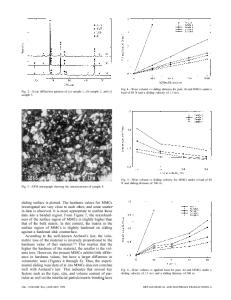Oxidation behavior of single-crystal Al 2 O 3 -fiber-reinforced Ni 3 Al-based composites
- PDF / 2,401,041 Bytes
- 7 Pages / 598 x 778 pts Page_size
- 77 Downloads / 421 Views
I.
INTRODUCTION
CURRENTLY, there exists a great deal of interest in developing intermetallic matrix composite materials for use at elevated temperatures. Research in this area has mainly been focused on the processing and mechanical properties, l~-4] The oxidation behavior, in contrast, has received little attention, t5,6] Since Al-based intermetallics, aluminides, exhibit good resistance to oxidation, it is only natural to assume that composites prepared from these compounds should also be resistant to oxidation. In a series of recent investigations it was demonstrated that the composites of Ni3Al-based, tTl Fe3Al-based, ts] NiAl-based, 19] and TiAl-basedt~~ intermetallic alloys individually reinforced with continuous polycrystalline A1203-based fiber, PRD-166,* showed a lack of resis*PRD-166 is a trademark of E.I. Du Pont de Nemours & Company, Inc., Wilmington, DE.
tance to oxidation. The PRD-166 is a 20-/,m-diameter polycrystalline A1203 fiber that contains approximately 20 wt pct partially stabilized ZrO2. lIb,t21 The low resistance to oxidation in aluminide matrix composites was postulated to be a result of the diffusion of O through the fiber/matrix interface, grain boundaries of the fiber, ZrO2 particles within the fiber, or gaps that existed between some of the fibers because of a lack of infiltration by the molten metal during composite processing, tT,8j The aim of the study undertaken was to determine the path that O uses to diffuse deep into the composites. In this set of experiments, single-crystal A1203, S, NOURBAKHSH, Professor and Department Head, W.H. RHEE, Graduate Student, O. SAHIN, Postdoctoral Research Associate, and H. MARGOLIN, Distinguished Research Professor, are with the Department of Materials Science and Engineering, Polytechnic University, Brooklyn, NY 11201. Manuscript submitted November 12, 1993. METALLURGICAL AND MATERIALS TRANSACTIONS A
SAPHIKON,* fiber was used as the reinforcement. The *SAPHIKON fiber is a trademark of Saphikon, Inc., Milford, NH.
fiber was incorporated into a series of Ni3Al-based alloys by pressure casting. Special precaution was exercised to prevent fiber/fiber contact and, therefore, to eliminate the possibility of O travel through the gaps between two fibers. It is hoped that the results of this investigation will provide an insight on the mechanism of oxidation in AlgO3-fiber-reinforced aluminide matrix composites.
II.
EXPERIMENTAL PROCEDURE
The Ni3Al-based alloys used in the investigation were provided by Armco Research Center (Middletown, OH). These were IC50 (Ni-21.7AI-0.34Zr-0.1B) and a binary Ni3A1 (Ni-25A1); all compositions are in atomic percent. Part of the binary Ni3A1 was subsequently prealloyed with 0.5 at. pct Cr by arc melting to produce a Ni24.9AI-0.5Cr alloy. The single-crystal A1203 fiber employed was obtained from Saphikon. The as-received continuous fiber, which had a diameter of approximately 150/zm, was cut into 50-mm-long pieces. These fibers were placed inside an alumina jig (Figure 1). The fibers in the jig were held at each end
Data Loading...











